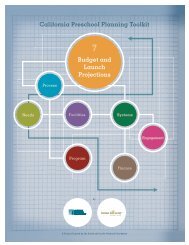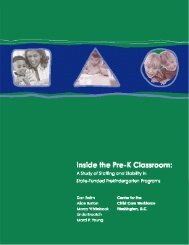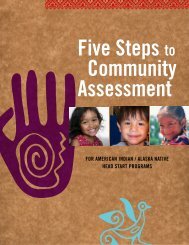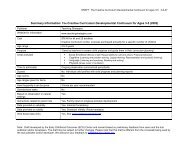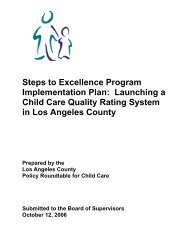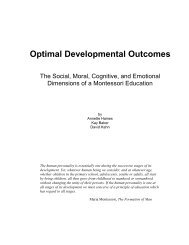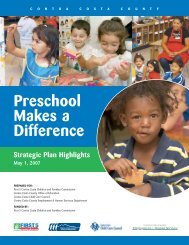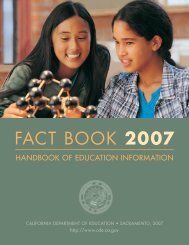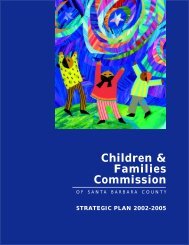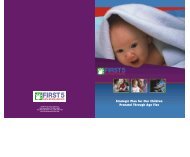Mapping the P-3 Continuum - Foundation for Child Development
Mapping the P-3 Continuum - Foundation for Child Development
Mapping the P-3 Continuum - Foundation for Child Development
Create successful ePaper yourself
Turn your PDF publications into a flip-book with our unique Google optimized e-Paper software.
is that CPC classes had a higher teacher-to-child ratio, as well as teacher aides, whereas ABCchildren were in <strong>the</strong> traditional classroom setting.The lessons learned from <strong>the</strong>se evaluation studies include:• The importance of a single delivery system <strong>for</strong> both <strong>the</strong> early and extended interventions• Reduced class sizes• Coordinated instructional delivery• A focus on school readiness in <strong>the</strong> early years• Building on that readiness in <strong>the</strong> subsequent years leads to smoo<strong>the</strong>r transitions andhigher rates of success in school <strong>for</strong> children• The duration of program participation is essential to long-term outcomes includingreduced dropout rates, grade retention, delinquency, and higher academic successIn short, a well-coordinated system with <strong>the</strong> goals of improving school outcomes and increasingparent involvement, as well as providing necessary support services over a number of years,constitute key lessons learned from <strong>the</strong>se evaluation studies.The French system of educationThe French-American <strong>Foundation</strong> 9 reports that in France, pre-kindergarten <strong>for</strong> all three-, four-,and five-year old children is a way to welcome children into French society. Beginning at threeyears of age, <strong>the</strong> French consider it normative <strong>for</strong> all children to enter <strong>the</strong> ecole maternelle. Itspurpose is not considered an intervention only <strong>for</strong> low-income and immigrant children, but anopportunity <strong>for</strong> all children.The French education system is an example of an integrated and intentional public educationsystem <strong>for</strong> all French children ages 3-18 years old. The curriculum was established by <strong>the</strong>French Ministry of Education, and is followed by every public school teacher. The goals andoutcomes of <strong>the</strong> curriculum are explicit, and teachers as well as children are expected to follow<strong>the</strong> established curriculum. The curriculum drives every activity that children are involved within <strong>the</strong> classroom. Highly trained teachers manage to implement <strong>the</strong> curriculum in creative waysto engage every child. The classroom environment is structured in a way that enables children topractice <strong>the</strong> skills that are expected of <strong>the</strong>m from year to year.In ano<strong>the</strong>r report by <strong>the</strong> French-American <strong>Foundation</strong>, 10 researchers devised a list of elementsthat make <strong>the</strong> education system in France one approach to P-3 from which <strong>the</strong> U.S. can learn.First, voluntary, free pre-kindergarten is available to all children beginning at two years of age.Although only 35% of two year olds attend preschool, almost all three-, four-, and five-year-oldsattend. Second, <strong>the</strong> quality standards <strong>for</strong> teachers and classroom curricula are high in France.Third, 10 percent more money is spent on children located in disadvantaged areas. Theseresources are used to reduce class size, reward teachers with bonuses, hire specialists, anddevelop community partnerships. Fourth, <strong>the</strong> French believe that early entry to <strong>the</strong> educationsystem helps children in <strong>the</strong> long run by increasing <strong>the</strong>ir linguistic, cognitive, social, andphysical skills. Fifth, <strong>the</strong> school system integrates children from immigrant backgrounds into <strong>the</strong>9 Cooper, C.J. (2002). Ready to learn: The French system of early education and care offers lessons <strong>for</strong> <strong>the</strong> UnitedStates. A report of <strong>the</strong> French-American <strong>Foundation</strong>.10 Neuman, M. J., & Peer, S. (2002). Equal from <strong>the</strong> start: Promoting educational opportunity <strong>for</strong> all preschoolchildren-Learning from <strong>the</strong> French experience. A report of <strong>the</strong> French-American <strong>Foundation</strong>.8



